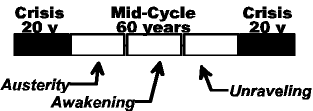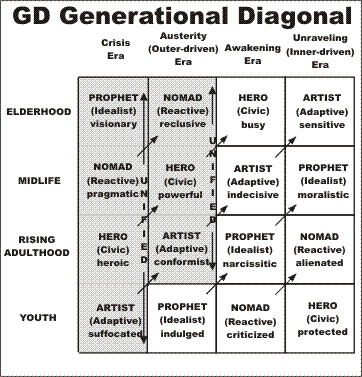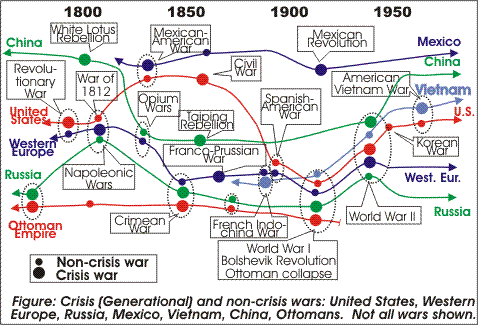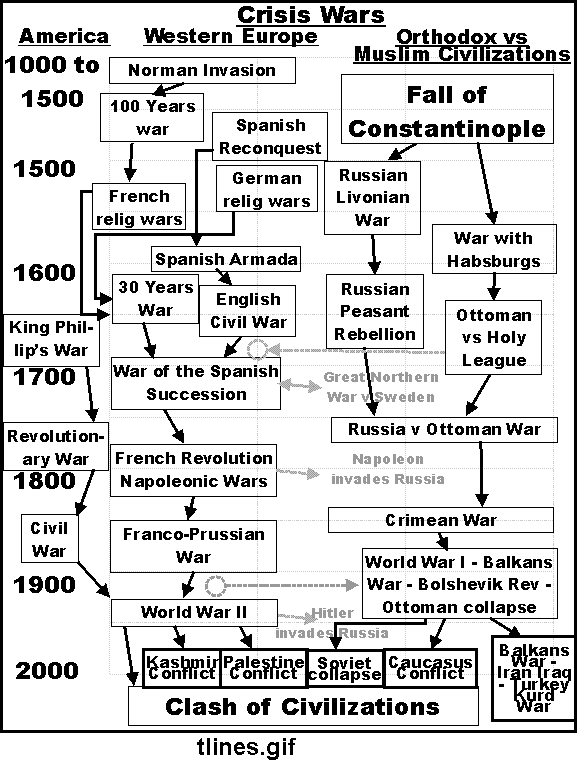
Dynamics

|
Generational Dynamics |
| Forecasting America's Destiny ... and the World's | |
| HOME WEB LOG COUNTRY WIKI COMMENT FORUM DOWNLOADS ABOUT | |
Palestine-Israel, Russia-Caucasus, India-Pakistan, China-Taiwan, Korea-Japan, and Western Europe are all becoming so tense that a spark could ignite a war in any of them, and a war in any of them would probably trigger a "clash of civilizations" world war.
For almost 20 years, historians have been discussing the possibility of a new major world war, a "clash of civilizations" between Western civilization and Muslim civilization, with well over a billion people on each side.
The concept was popularized by Harvard professor Samuel P. Huntington in his 1996 book, The Clash of Civilizations and the Remaking of World Order. In his book, he analyzed Muslim civilizations around the world and discovered, in particular, that population growth was much higher in Muslim than in Western countries, creating a "youth bulge" which, he predicted, will lead to the clash by the 2010 time frame.
Today, thanks to Generational Dynamics, we can get a pretty firm idea of the likeliest scenarios that will lead to the "clash of civilizations" war.
The six regions that we've selected are the most likely to trigger a major war mainly because a war in any of these reasons will quickly force America to join the war on one side or the other, usually because of existing treaties. Also, as we'll explain, each of these regions is in a "generational crisis" period, which means that even a small war is likely to spiral out of control into a very big war.
Here are the six regions:
The above regions are all dangerous for the obvious reasons given, but those regions are particularly important for another reason: They're all in a "generational crisis" period.
As we'll explain, we're at a unique time in history because 60 years have passed since the end of World War II, and all the nations who fought in World War II are now making rapid generational changes, all at the same time. In each nation, all the people who have personal memories of the genocidal horrors of WW II are all disappearing (retiring or dying), all at once, and history tells us that that's when the next world war is likely to begin.
From the point of view of Generational Dynamics, different regions throughout history have been on different "timelines," which indicate when major genocidal crisis wars occur. In the last century, most of these distinct timelines have merged into two major ones: A World War II timeline, and a World War I timeline. Of the six regions above, Russia-Caucasus is on the World War I timeline, and the others are on the World War II timeline.
Now let's explain this more fully.
The major findings of Generational Dynamics begin with the discovery that there are two kinds of wars: crisis (or generational) wars and non-crisis (or mid-cycle) wars.
Crisis wars are cyclic within a society, region or nation. They're the most horrible kinds of wars. They're so horrible and they traumatize a nation so much that there's unanimous agreement to do everything possible to prevent any such war from ever happening again. When the last generation of people who lived through the crisis war disappear (retire or die) all at the same time, then the nation enters a new crisis period, leading to a new crisis war. That's why a new crisis war typically begins around 60 years after the previous one ends.
Some people may think that America has been immune to genocidal crisis wars, but in fact there have been two since the nation's founding.
America's most recent crisis war was World War II. Before it was over, we firebombed and destroyed major cities like Dresden and Tokyo, with the intention of destroying the cities and their inhabitants, including millions of civilians. And we dropped nuclear weapons on two Japanese cities for exactly the same reason.
I'm not blaming the Allies for taking these genocidal actions, especially since our enemies would have done the same to us. But I'm making the point that genocidal actions like these always occur in crisis wars, and every nation and society has these crisis wars throughout it's history. Crisis wars are fundamental to human DNA, and are a requirement of "survival of the fittest."
|
Other 20th century wars did not exhibit anything like this kind of genocidal fury. America didn't use nuclear weapons in the Vietnam War, and in fact the war was stalled by bitter political recriminations, which is typical of non-crisis wars. And World War I had no such genocidal fury either, and in fact was mostly a static war in the West, which ended when Germany unexpectedly capitulated, long before it had to.
Prior to World War II, America's previous crisis war was the Civil War. At the climax of the Civil War, President Abraham Lincoln OKed a "scorched earth policy": General Sherman marched through Georgia, not only killing everyone in sight, but also destroying all homes and crops so that any survivors starved to death.
This kind of genocidal behavior did not occur in any of America's other wars -- the Gulf War, the Vietnam War, the Korean War, World War I, the Spanish-American War, or the Mexican-American war.
The latter wars are non-crisis wars. Non-crisis wars are political wars -- they come from the politicians. They can start at any time a politician decides, and they can end at any time.
Crisis wars come "from the people" rather than from the politicians. They're almost like sex in their emotional ferocity. The recur in any society at roughly 70-90 year intervals. Crisis wars may get off to a bumpy start, but once they pick up speed they can't be stopped, and end with a genocidal fury.
About 55-60 years after one crisis war ends, the last generation of people who have personal memories of the genocidal horrors of the preceding crisis war, the country enters a "generational crisis" period. This appears as a substantial change in attitudes in the public in general. We've already begun to see this in America, with the surprising and unexpected rise of "moral values" as a factor in the last election. Whenever any country enters a generational crisis period, public opinions continue to harden until a new crisis war breaks out.
Opinions have been hardening in each of the six regions we're discussing. Whether it's Palestinians versus Jews, or Taiwan versus Beijing in China, or the Beslan school massacre in the Caucasus, or the sudden, rapid hostility between Christians and Muslims in the Netherlands, opinions are hardening rapidly in these regions around the world.
We've said that crisis wars tend to occur in 70-90 year cycles in each society, region or nation, but let's be more specific.
In studying the frequency of crisis wars, we've found that the most useful figure to study is the number of years from the end of one crisis war to the beginning of the next.
In an analysis of over 100 crisis wars in nations around the world throughout history, the number of years from the end of one crisis war to the beginning of the next varied from 40 to 117 years, according to the following table:
Fraction
# years of total
------- --------
0- 40 0%
41- 49 11%
50- 59 33%
60- 69 25%
70- 79 16%
80- 89 4%
90- 99 6%
100-117 5%
These figures give an idea of the distribution of crisis wars, and permit an estimate of how frequently crisis wars occur.
The crisis wars are like huge markers on the timeline of history. In between those markers are smaller markers for other significant events. Generational Dynamics has a rich supporting theory that explains how one crisis war leads to the next.
 |
The mid-cycle period between the end of one crisis war and the beginning of the next generational crisis period is broken up into three generational segments:
The new Crisis period often begins with some surprise -- such as a financial crisis (1929 stock market crash) or a terrorist act (9/11). The next crisis war begins a few years after the crisis period begins.
Children born in these different periods grow up with characteristics unique to their generation. The differences between people in the same generation are much smaller than the differences between generations.
Here are the four generational archetypes:
|
 |
The above diagram ties everything together by showing how generations change through the entire cycle.
Generational Dynamics is based on work done by historians William Strauss and Neil Howe in the 1980s and early 1990s on generational changes in Anglo-American history. They developed their work by studying hundreds of histories and diaries through Anglo-American history dating back to the 1400s. They were able to prove that the generational archetypes (Hero, Artist, Prophet, Nomad) occur repeatedly throughout history, always cycling in exactly that order.
Their work is documented in two books, Generations: The History of America's Future, 1584 to 2069 and The Fourth Turning: An American Prophecy.
Strauss and Howe's work is powerful and fascinating because it provides insight not only into the history of our country, and also into our own personalities, as it helps us understand how generations affect us all. If you wish to understand the flow of American generations, including your own place within recent generations, the above books are good sources.
However, they imposed substantial restrictions on their theory. They say that it applies only to Anglo-American society. They say that it's restricted to modern societies where, "as in America, generations are left free to develop and express their own personalities." According to the authors, the model can't apply to pre-modern societies, or even for most modern societies. However, they suggest that other modern societies should be tested by reading histories, biographies and diaries written by people in those nations.
Generational Dynamics begins where Strauss and Howe leave off, and removes the restrictions. While they base the generational cycle on Awakening periods, Generational Dynamics redevelops the theory starting from crisis wars, and shows that the generational paradigm applies to all societies, regions and nations throughout history.
For over two years, my web site, http://www.GenerationalDynamics.com , has been providing hundreds of forecasts and predictions based on Generational Dynamics. Some of these forecasts have been general, and some have been very specific, but none has been proven wrong. This web site has produced results which I would have believed impossible three years ago.
The forecasting methodology has been something of an art, but I've always been aware that I need to boil it down to a science if it's to attain credibility. The following is an attempt to do so in writing.
In it's pure form, Generational Dynamics provides only a severely restricted forecasting methodology:
However, it turns out that even with these restrictions, the forecasting methodology can give you a great deal more information than you might think, mainly because you can firmly predict some negatives.
For example, once you know for certain that there will be a new Arab-Jewish crisis war in the next few years, we can predict with certainty that every peace plan will fail. Once we know that Iraq is in an Awakening period, then we can predict with certainty that there won't be a Sunni-Shi'a civil war. Once you know that a crisis war has begun in earnest in Darfur, then you can predict with certainty that it will run its course, and that the UN will fail to stop it.
Even though these examples are all negative predictions, they still contain a great deal of important information.
So here are some techniques in the forecasting methodology:
 |
There are many further examples and discussions on my web site, and these articles provide more guidance and information on making forecasts and predictions.
Don't expect this to be easy. When I was first getting started, it often took me three or four days of studying various sources just to analyze a single war. As time has gone on, I've been able to proceed much more quickly, but it still requires study of several sources to determine a country's timeline.
In the previous section, we gave some examples of specific forecasts, but they were all negative (there will NOT be a civil war in Iraq).
Positive forcasts are like the saying, "A watched pot never boils." You know that the water will boil some time, but you don't know when. So you can say that there'll be a major Arab-Jew crisis war in the next few years, but you can't say exactly when.
However, it should be possible to give a probabilistic forecasts.
We start with this table, which also appears earlier in this article. It shows the number of crisis wars that began in a specified number after the end of the previous crisis war:
Fraction
# years of total
------- --------
0- 40 0%
41- 49 11%
50- 59 33%
60- 69 25%
70- 79 16%
80- 89 4%
90- 99 6%
100-117 5%
This estimate is based on principles of Generational Dynamics which itself is based on studying repeating patterns throughout history.
I took the data that went into this table, I did some smoothing and made some computations involving conditional probabilities, and came up the following table, which gives the probability of a new crisis war beginning in that year:
|---|------|------|------|------|------|------|------|------|------|------| | Yr| +0 | +1 | +2 | +3 | +4 | +5 | +6 | +7 | +8 | +9 | |---|------|------|------|------|------|------|------|------|------|------| | 40| 0.00%| 0.11%| 0.23%| 0.34%| 0.46%| 0.58%| 0.70%| 0.85%| 0.99%| 1.15%| | 50| 1.31%| 1.47%| 1.68%| 1.90%| 2.13%| 2.37%| 2.83%| 3.33%| 4.31%| 4.31%| | 60| 4.32%| 4.32%| 4.32%| 4.32%| 4.33%| 4.33%| 4.33%| 4.33%| 4.34%| 4.34%| | 70| 4.34%| 4.34%| 4.35%| 4.35%| 4.35%| 4.35%| 4.36%| 4.36%| 4.36%| 4.36%| | 80| 4.37%| 4.37%| 4.37%| 4.37%| 4.38%| 4.38%| 4.38%| 4.39%| 4.39%| 4.39%| | 90| 4.39%| 4.40%| 4.53%| 4.68%| 4.84%| 5.01%| 5.20%| 5.41%| 5.63%| 5.87%| |100| 6.14%| 6.44%| 6.77%| 7.14%| 7.56%| 8.04%| 8.60%| 9.24%|10.00%|10.91%| |110|12.02%|13.40%|15.18%|17.54%|20.85%|25.00%|25.00%|25.00%|25.00%|25.00%| |---|------|------|------|------|------|------|------|------|------|------|
Thus, America's last crisis war ended in 1945, which is 60 years ago, so the probability of a new crisis war beginning in 2005 is 4.32%.
So, we can't predict when America's next crisis war will begin, but we can use just one fact -- the time since the end of the last crisis war -- to determine that the probability that a new crisis war for America will begin in 2005 is 4.32%.
Now, let's continue with this exploration by using some additional information.
Another major finding of Generational Dynamics is that, while each society or nation is on its own timeline of crisis wars, over the centuries the timelines merge, creating larger and larger wars.
In the 20th century, most of the timelines merged into the two great World Wars. World War I was centered around Eastern Europe, and can best be thought of as a war between the Orthodox Christian and Muslim civilizations.
World war II was centered around Western Europe and can best be thought of as a continuation of wars that have dominated Europe for millennia.
 |
Today, we're at a unique time in history when even the East European and West European timelines are merging into a "clash of civilizations" world war, with the West on one side and the Muslim civilization on the other.
This brings us back to the six dangerous regions that we began this article with:
Each of these regions had separate crisis wars in the 20th century, with the first five on the WW II timeline, and the last (Russia and the Caucasus) on the WW I timeline.
As an aside, note that other crisis wars on the WW I timeline have already completed; these include the Iran/Iraq war of the 1980s, and the Turkey/PKK-Kurd war of 1984-2000. That's why most of the coming conflict is on the WW II timeline, with a sprinking of the WW I timeline merged in.
However, the biggest of the WW I timeline wars has yet to be refought: the Russian revolution and the massive civil wars of the 1920s.
Now here's the assumption that I'm making: If a crisis war breaks out in any one of the above six regions, then it won't remain a regional crisis war for long; instead, it will end up engulfing America and all six regions, ending up as a new world war.
Thus, what we need to do is compute the probablity that a crisis war will break out in at least one of the above six regions.
In order to do that, we have to make one more assumption: That before the world war begins, the probability of a crisis war in any one of those six regions is independent of the probability of a crisis war in any of the others. This is in fact probably true, since each of the previous crisis wars was a separate war.
This assumption will allow us to use the independent probability rule to make computations.
So the first thing we need to do is compute the probability of a crisis war in each of the six regions. To do this, we used the same table of probabilities that we used above to compute the 4.32% value for America.
So, it's now appropriate we ask: What's the probability that at least one of these regions will have a crisis war in 2005?
For that, we need to first compute the probability P of a crisis war beginning in 2005 for each region separately, where Y is the year of the last crisis war:
| Region | End of last crisis war | P for 2005 |
|---|---|---|
| World War I timeline | ||
| Russia-Caucasus | Russian revolution, civil war between Lenin and Trotsky, Y=1928, 75 years ago | P=4.36% |
| World War II timeline | ||
| Western Europe-Pacific | World War II, Y=1945, 50 years ago | P=4.32% |
| Palestine-Israel | War between Arabs and Jews, Y=1949, 46 years ago | P=2.83% |
| India-Pakistan | Muslim-Hindu conflict, World War II. Y=1945, 50 years ago | P=4.32% |
| China-Taiwan | Civil war between Mao Zedong and Chiang Kai-shek Y=1949, 46 years ago | P=2.83% |
| Korea-Japan | Japanese occupation of China, World War II, partitioning of Korea. Y=1946, 49 years ago | P=4.31% |
So now we use the rules of independent events to compute the probability of a crisis war in 2005 in at least one of the above regions is:
1 - (1-.0432)*(1-.0283)*(1-.0432)*(1-.0436)*(1-.0283)*(1-.0431) = .2089 = 20.89% ;
So, according to this calculation, the probability of a new crisis war in at least one of these regions in 2005 is about 21%, or a little more than 1 in 5. If it doesn't happen in 2005, then the probability in 2006 will be a little bit more, still around 21%.
However, this 21% result assumes you know nothing else about the countries involved, other than the one fact - how long it's been since the last crisis war. My personal feeling is that the international situation has deteriorated significantly just in the last year, and the probability of a major crisis in 2005 is definitely higher in 2005 than it was in 2004. I note in particular the following:
|
If I had produced a list like this at the end of 2003, the list would have been shorter, with fewer specific items. That's why I say that things have gotten significantly worse in the last year.
Here's what we may be looking at: The crisis wars in Darfur and (possibly) Côte d'Ivoire may mean that we'll see a new crisis war every few months, until one triggers a larger war; a recession in 2005 may trigger a crisis war somewhere, or it may trigger an international financial crisis.
If "nothing happens" in 2005, then my expectation is that the above list (with the exception of the first item) will only get longer for 2006.
We've used the example of the six most dangerous regions in the world today as a framework to describe the theory behind Generational Dynamics and the Forecasting Methodology. Generational Dynamics is a very rich theory, but this article contains a summary of the major points.
We've used this presentation to estimate the likelihood of a major "clash of civilizations" world war in the next few years. We're at a unique time in history where all the nations that fought in World War II are simulataneously entering a new generational crisis period, and so the likelihood of a new world war is increasingly high. We used probabilistic forecasting, under certain named assumptions, to estimate that there is approximately a one in five chance that the war will begin in 2005.